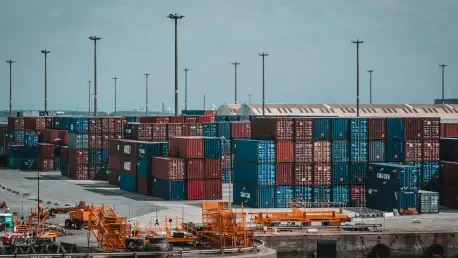In an era where software supply chain vulnerabilities pose a staggering risk to global enterprises, with over 80% of organizations reporting at least one breach due to open-source code flaws, Chainguard stands out as a transformative force in container security. This market analysis delves into the company’s pioneering approach of delivering minimal, hardened container images with daily updates, addressing a critical gap in cybersecurity for DevSecOps teams. The purpose of this examination is to unpack Chainguard’s impact on the industry, analyze current trends in secure container management, and forecast future directions in a landscape increasingly defined by cloud-native technologies. Understanding these dynamics is vital as businesses grapple with escalating threats and seek robust solutions to safeguard their digital infrastructure.
Market Trends Driving Container Security Evolution
The container security market is undergoing a seismic shift, propelled by the rapid adoption of cloud-native architectures and the inherent risks of open-source software dependencies. As organizations increasingly rely on containers for scalable, efficient deployments, the attack surface has expanded, with vulnerabilities in third-party code becoming a primary entry point for cyber threats. Industry reports indicate that unpatched flaws in container images contribute to nearly half of all supply chain attacks, underscoring the urgency for innovative defenses. Chainguard’s model of minimal images—stripping away unnecessary components to reduce risk—aligns with a broader trend toward lean, purpose-built software environments that prioritize security over bloated functionality.
This trend is further fueled by regulatory pressures and industry standards pushing for greater transparency in software composition. The adoption of software bills of materials (SBOMs) as a tool for documenting and verifying code integrity is gaining traction, with governments and enterprises demanding attestations to ensure trust. Chainguard’s integration of SBOMs with signatures for its nearly 1,500 secure images positions it as a leader in this space, capitalizing on market demand for accountability. However, the challenge lies in balancing minimalism with operational needs, as some workloads require more complex configurations that could resist such streamlined approaches.
A parallel development is the growing emphasis on speed in vulnerability remediation. Traditional patching cycles, often spanning weeks or months, are becoming obsolete in the face of fast-moving threats. The market is pivoting toward solutions that offer near-real-time updates, a niche where Chainguard excels with its daily rebuilds from source code and patching timelines of 7 days for critical issues and 14 days for others. This responsiveness sets a new benchmark, pushing competitors to adapt or risk obsolescence in an environment where delays can be catastrophic.
Chainguard’s Dominance and Competitive Positioning
Unpacking Growth Metrics and Market Penetration
Chainguard has emerged as a cybersecurity unicorn with a valuation of $3.5 billion, driven by a recent $356 million Series D funding round that reflects robust investor confidence. Customer adoption has surged fivefold in a short span, spanning diverse sectors such as technology, finance, manufacturing, and government, including entities meeting stringent FedRAMP High and DoD Impact Level 5 standards. This broad uptake highlights the universal appeal of secure container solutions, particularly in high-stakes environments where compliance and protection are non-negotiable. The company’s ability to cater to such varied industries suggests a scalable model, though sustaining this growth without compromising service quality remains a critical concern.
Standing Out in a Crowded Arena
In a competitive landscape featuring established players like Aqua Security, Docker, and Snyk, as well as new entrants like Minimus with its $51 million-backed trusted image registry, Chainguard carves a distinct niche through its focus on minimal, daily-updated images. Unlike Snyk’s emphasis on container scanning or Docker’s broader platform tools, Chainguard’s strategy reduces the attack surface at the source, offering a proactive rather than reactive defense. This differentiation has fueled its market traction, though the rise of alternatives indicates a maturing sector where innovation must be relentless to maintain a lead. The risk of commoditization looms as more vendors adopt similar minimalist principles, potentially eroding Chainguard’s unique edge.
Expanding Portfolio as a Market Differentiator
Beyond core container management, Chainguard is broadening its footprint with a suite of products tailored to the evolving needs of DevSecOps. Offerings like Chainguard OS, a minimal Linux distribution with continuous micro-updates, and preview solutions such as Chainguard Libraries for Python and Java, address vulnerabilities across development stacks. Additional innovations, including Chainguard VMs for zero-CVE host images and Chainguard Factory for Kubernetes-based automation, signal a comprehensive approach to securing software ecosystems. This diversification strengthens Chainguard’s position as a one-stop security partner, though it also stretches resources and raises questions about focus in a highly specialized market.
Projections for Container Security Market Dynamics
Looking ahead, the container security market is poised for significant evolution, with projections indicating a shift toward automated, proactive solutions over the next few years from now to 2027. The integration of artificial intelligence for vulnerability detection and response is expected to become a standard feature, potentially enhancing Chainguard’s daily update model with predictive capabilities. Regulatory frameworks will likely tighten further, mandating SBOM transparency and rapid patching as baseline requirements, which could cement Chainguard’s relevance while pressuring competitors to align with these standards. The market’s growth trajectory suggests a compound annual growth rate that could outpace broader cybersecurity sectors, driven by cloud-native adoption.
Geopolitical factors, including the rising threat of nation-state cyberattacks, are anticipated to shape market priorities. As critical infrastructure and government systems become prime targets, vendors like Chainguard, serving sensitive sectors, may face heightened scrutiny and risk. Industry consolidation or strategic partnerships could emerge as a response, with larger players potentially acquiring niche innovators to bolster defenses. For Chainguard, maintaining agility while scaling to meet these sophisticated threats will be paramount, especially as its prominence makes it a potential target for advanced persistent threats.
Another forecast centers on market differentiation through user experience and integration. As container security solutions proliferate, ease of deployment and seamless embedding into existing development pipelines will distinguish leaders from laggards. Chainguard’s focus on usability alongside security positions it favorably, but continuous investment in customer-centric innovation will be essential. The coming years may see a convergence of container security with broader DevSecOps tools, creating a more integrated ecosystem where standalone solutions face adoption challenges unless they adapt to holistic demands.
Reflecting on Market Insights and Strategic Pathways
Looking back, this analysis reveals that Chainguard has carved a formidable presence in the container security market through its minimalist, daily-updated images and rapid patching ethos, validated by a $3.5 billion valuation and widespread adoption across critical sectors. The competitive landscape has grown increasingly crowded, with diverse approaches to securing software supply chains, while emerging threats like nation-state attacks underscore the stakes of innovation. Market trends have decisively shifted toward transparency, speed, and automation, aligning with Chainguard’s strengths but also challenging its long-term differentiation.
For businesses navigating this terrain, strategic steps include adopting minimal container architectures to shrink attack surfaces, prioritizing vendors with robust SBOM frameworks for verifiable trust, and establishing internal protocols for patching within tight windows akin to Chainguard’s 7-14 day cycles. Exploring partnerships with complementary tools, such as scanning or broader DevSecOps platforms, offers a layered defense against multifaceted risks. As the market continues to evolve, staying attuned to regulatory shifts and investing in automation promises to fortify resilience, ensuring that organizations not only mitigate current vulnerabilities but also anticipate the next frontier of cyber threats.









